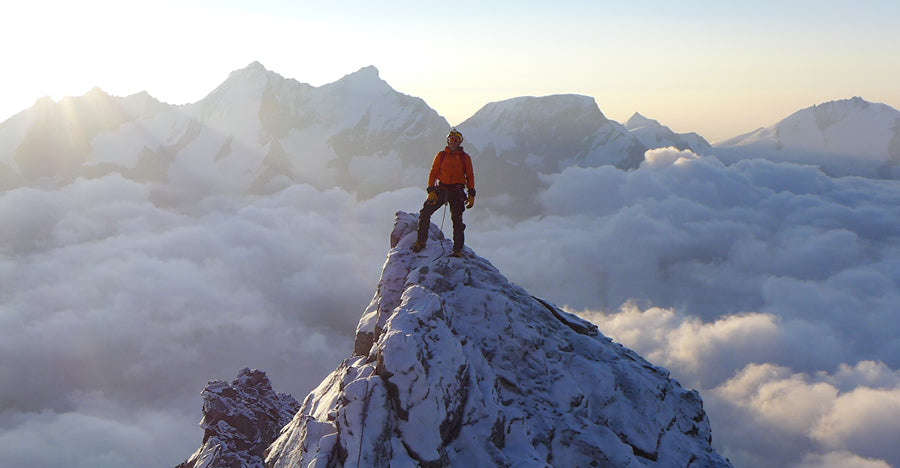
Lonely alpine classics
- Mountaineering

Text & Photos: Tim Neill
Tim Neill is a very experienced British mountain guide who has been climbing since the 90s. He loves adventurous routes and has a lot of alpine experience. That's why we asked him to tell us about three little-used alpine classics.
________
In the following we present you three tours in the western Alps - in different degrees of difficulty, but similar style. By European standards, it's very quiet and secluded on all three routes, although they all go up well-known four-thousanders. Since these are long alpine tours, you'll need a good hand for the right conditions and a well-coordinated team. You will be confronted with early starts, brittle rock, solid climbing, climbing in snow without crampons as well as climbing from rock with crampons - but also with breathtaking views ... and with energy-sapping long descents.
Weisshorn (4.506m), east ridge (ZS)

This is a great tour in many ways! On the first day, you climb from Randa in the Mattertal to the pretty little Weisshorn hut. This will warm up your muscles ahead of time. I recommend leaving early so you have time to rest and explore the entrance.
On the second day you should start early before dawn. In the darkness, you will cross a short snowy passage, followed by sophisticated rocky outcrops to an exposed scramble. As the sun slowly rises, you will reach the crest of the spectacular east ridge.
Then, as if on a knife edge, the tour leads over small towers with wonderful rock quality and finally to the last ridge. This passage is very exposed. At best, you will find good snow without ice on the way back. Be careful!
The Weisshorn can be seen from the many points of the Alps. In turn, the view from its summit is gigantic. You are hopefully fit enough to enjoy it to the fullest and descend safely afterwards.
I have done this tour a few times. My tip: Don't take too much for the next day!
Equipment:
A 40m rope is sufficient. There are some short ledges over which you can abseil via drilled rings. Also a small set of medium size cams, a small set of slings and some express slings. Ice axe, crampons and at least one ice screw if the ridge is icy. Most important is good crampon technique! Good acclimatization is also essential. And a camera.
The Grandes Jorasses (4,208m), Tronchey Ridge (S/SS)

This is definitely the wildcard of this list. I climbed it a few years ago during a final exam for mountain guides. Fortunately, all of the prospective guides who were there were familiar with this type of terrain.
Already the ascent from Val Ferret to the Jachia bivouac hut is a serious alpine tour and very demanding. The hut book will probably always have enough space for new entries. It is an insanely beautiful, breathtaking place.
After a very early start, the route goes over a demanding ridge to a saddle between the wild east and south walls of the Jorasses. From here on, the route goes over and around large towers. For this, the guide gives only scanty information. Finally, one climbs over mixed terrain to Point Walker. The quote of the day for us Brits "This is Big Country!" (note: name of a British pop band and their song). Even after other routes like "Walker Spur" or "Colton Macintyre" on the same summit, I find that this tour is simply an insane experience.
We made it back to the road without headlamps then, had a pizza and prepared for the next big day.
Although this is probably a route for alpine connoisseurs and experts, here will divide the minds of the few climbers. It is undoubtedly a demanding undertaking on a great mountain that offers every conceivable alpine terrain.
Equipment:
A sturdy 60m single rope or a double rope (sharp edges!), a set of cams, wedges and slings, an ice axe and crampons, one or two ice screws for the descent down the south face of the Jorasses, extra clothing and a small stove just in case. Rifugio Boccalatte (staffed in summer) is a beautiful, inviting place to take a break if you run out of steam here. As a guide to the times in the climbing guide, you should be able to do a route like the "Frendo Spur" on the Aguille die Midi as a relaxed morning climb.
Mont Blanc (4.810m), Grand Pilier d'Angle in ice (AS)

The summer of 2014 was not a picture-perfect summer. The good thing is that the north walls were in good condition throughout the summer and into the fall during the good weather windows.
The south side of Mont Blanc is fantastic. You can go up quite far by train, but the described route and many other tours start in the valley. The Innominata ridge, the pillars of Mont Brouillard, the Peuterey Integral and of course the central Frêneypfeiler are all classics and alpine must-dos. My alpine dream are the ice gullies on Brouillard and the rock climbing over the Grand Pilier D'Angle. Climbing Mont Blanc from the Italian side over ice is simply indescribable.
The approach to the wall is quite complicated and also dangerous: from the Kuffnergrat you get directly under the huge Brenvaflanke to Col Moore - I have turned back here even in drier conditions.
Here, too, it's best to start at night in cold conditions. On compact snow you will advance quickly. We climbed a lot solo, belaying here and there with the rope. In the lower part we climbed the Bouchard route, which takes you in a logical line to the Boivin/Vallencant Gully, which you ideally reach at sunrise. Then it's over the upper slope of the mountain to the final Peuterey Ridge. If it's cooler in the fall, you can climb much of the route in bright light. As with the Droites, you can go here, depending on the conditions, many variants - but then has a very long descent ahead.
On the summits of the Grand Pilier D'Angle (4,243m), Mont Blanc de Courmayeur (4,748m) and Mont Blanc itself, you will be taken back to a world with other people. For the descent, many variants are available. One of them is the Pope route via the friendly Gonella hut, a really nice path on the wild, Italian side. It is best to have a car on this side of the valley.
Equipment:
Long ropes with small diameter, material with which you can move quickly in terrain A1 4/5, stove, bivouac equipment (depending on speed and conditions), luck and one or two good rope partners.
It's not easy to choose three alpine classics. Because each tour burns itself into my brain as a memory, even long after I have recovered from the physical exertions. Here I have told you about three adventures that I had the pleasure of experiencing together with great people, where the conditions were right and the stars were aligned. I wish you good luck and success!




